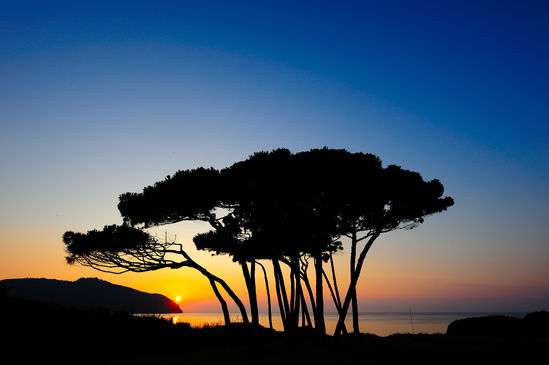
Küsten der Toskana
Landschaftliche Vielfalt, Abwechslung und zahlreiche kulturelle und architektonische Höhepunkte in unmittelbarer Nähe: Dadurch zeichnet sich die toskanische Küste aus, die sich über eine Länge von insgesamt fast 400 Kilometern entlang des Tyrrhenischen Meers erstreckt. Sie wird in vier Teilabschnitte untergliedert, von Nord nach Süd sind das: die Apuanische Küste, die Versilia, die Etruskische Küste und die Maremma-Küste.
Die Apuanische Küste – Badeurlaub und mehr
Die Apuanische Küste oder Apuanische Riviera liegt zwischen den Mündungen der Flüsse Magra und Versilia. Sie ist durchgängig flach und bietet auf etwa 13 Kilometern Länge viele große und schöne Strände. Nur ein kleiner Teil davon ist frei zugänglich. Die meisten sind öffentliche Strandbäder (Bagni) und kosten Eintritt. Zudem haben viele der Hotels entlang der Apuanischen Riviera eigene Privatstrände. Die Apuanische Küste eignet sich perfekt für Badeurlaub mit der ganzen Familie, es gibt aber auch zahlreiche Wassersportzentren, die z.B. Windsurfen und Segeln anbieten. Schöne Wanderwege und Mountainbike-Strecken in den nahe gelegenen Apuanischen Alpen laden zu sportlicher Betätigung an Land ein. Und auch einige sehenswerte Städte in der Nähe, wie Carrara, die Heimat des berühmten Marmors, Pisa oder Lucca sind immer einen Besuch wert.
Die Versilia – wo die Mondenität zu Hause ist
Vielfältig ist auch die Versilia, der rund 30 Kilometer langen Küstenabschnitt, der sich südlich anschließt. Die Region wurde schon im 19. Jahrhundert zur beliebten Urlaubsregion und ist geprägt von mondänen Seebädern wie Forte dei Marmi, Marina di Pietrasanta, Lido di Camaoire und Viareggio. Schicke Hotels und Villen aus der Belle Epoque, aber auch kleinere Pensionen und Ferienwohnungen – für jeden Geldbeutel etwas – stehen für die Sonnenhungrigen und Strandurlaubliebhaber aus Italien und der ganzen Welt bereit, die im Sommer die Versilia „überfluten“. Doch auch Nachtschwärmer und Kulturliebhaber kommen hier voll auf ihre Kosten. Für Letztere bietet sich beispielsweise ein Besuch im Örtchen Viareggio an, das für seine Karnevalsfeiern bekannt ist. Ein Karnevalsmuseum bietet das ganze Jahr über die Möglichkeit, sich Nachbauten der schönsten allegorischen Wagen anzusehen. Zudem sind im Musei civici Musikinstrumente aus unterschiedlichen Epochen und Ländern ausgestellt.
Die Etruskische Küste – abwechslungsreiche und reizvolle Landschaft
Mit etwa 100 Kilometern etwas länger und landschaftlich sehr abwechslungsreich präsentiert sich die Etruskische Küste, die sich zwischen Livorno im Norden und Piombino im Süden erstreckt. Felsige Abschnitte und Steilküsten wechseln sich mit langen Sand- und Kieselstränden ab. Versteckte kleine Buchten sind nur zu Fuß oder übers Meer erreichbar. Die Strände sind oft umgeben von duftenden Pinienwäldern, die vor etwa 200 Jahren als Schutz gegen die teilweise sehr starken Winde angelegt wurden. Ihren Namen erhielt diese Küste, weil hier zahlreiche historische Relikte aus der Etruskerzeit gefunden wurden. Baden, Surfen, Fahrradfahren, Wandern – das und noch viel mehr kann man bei ganzjährig mildem Klima auch an der Etruskischen Küste unternehmen. Historische Städte wie Livorno mit einem der wichtigsten Häfen Italiens und San Vincenzo laden zum Sightseeing ein.
Die Maremma – das Naturparadies
Den südlichen Abschluss der toskanischen Küste bildet die Maremma-Küste. Dieser Abschnitt beginnt bei Follonica und reicht bis zur Mündung des Flusses Chiarone an der Grenze zur Region Latium. Landschaftlich ist die Maremma ähnlich abwechslungsreich und reizvoll wie die Etruskische Küste. Castiliogne della Pescaia mit seiner bewohnten Burg, von der man einen phantastischen Ausblick auf die vorgelagerten Inseln hat, gilt als einer der schönsten Küstenorte der Toskana. Ein wahres Paradies ist auch die Unterwasserwelt des Meeres an der Maremma mit seiner äußerst reichen Fauna und Flora. Folglich wurden hier einige Meeresschutzgebiete ausgewiesen. Und auch an Land wird viel Wert auf Naturschutz gelegt. Bestes Beispiel dafür ist der seit 1975 bestehende Maremma-Nationalpark. Der Parco Regionale della Maremma, wie er in der Landessprache heißt, bietet auf etwa 100 Quadratkilometern ein unglaublich vielfältiges, naturbelassenes, intaktes Ökosystem mit seltenen Tieren (Steinmarder, Wildkatzen, zahlreiche Vogelarten).
Fazit: Die toskanische Küste ist nicht nur wunderschön, sondern hat auch touristisch unglaublich viel zu bieten. Dazu zählt sicherlich auch die hervorragende Wasserqualität im gesamten toskanischen Küstenbereich. Beleg dafür ist auch die jährliche Auszeichnung vieler Strände mit dem Umweltsiegel „Blaue Flagge“, bei dem nicht nur die Wasserqualität, sondern auch die Sauberkeit am Strand und in den sanitären Einrichtungen berücksichtigt wird.
